“Crimes of Grindelwald” Set Visit Interview: Colleen Atwood
Colleen Atwood, costume designer for Fantastic Beasts: Crimes of Grindelwald, shared some wonderful insights into the costumes we’ll be seeing in the film this November. Atwood spoke on Jude Law and the spirit of young Dumbledore, how character growth affected the evolution of costumes, some changes to the Hogwarts uniforms, and her inspiration for the noir feeling of this film.
Press: Tell us about costuming a young Dumbledore.
Colleen Atwood: Well, Jude [Law] had some thoughts about what he felt the younger spirit of Dumbledore was, which was the favorite teacher that all the kids liked, sort of a mentor to some of the outsiders and sort of embraced [a] special kind of magical powers. And so with that approach, Dumbledore was sort of vaguely purplish tones in the Potters, so I sort of backed into that, but I didn’t use purple; I used grays and softer tones that were very approachable. His clothes have a soft texture, so they feel lived in and at the same time, a little bit different [from] what everyone else in the school would wear, more approachable. He has a great coat that everybody loved; he has a big corduroy overcoat that he wears for a scene in the fog. And Jude looks great. He’s a great-looking man. So it doesn’t hurt.
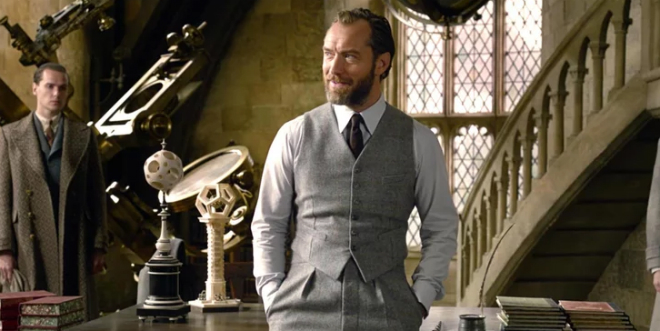
Press: How have Newt’s costumes evolved from [Film] 1 to [Film] 2?
Colleen: Well, what happened with Newt is, we all sort of fell in love with the blue coat. He’s done a little better in the world on the outside. His clothes are a little bit nicer quality. They’re not quite as rumply; they’re a little more urban, I’d say. He’s written a book and he’s become acknowledged for who he is. And what I did is, I took a gray fabric that I found that I had woven for the film because I found an old piece, and then the mill luckily reproduced it for me, and then we just wanted a little bit of a hint of blue, so I did a screen over it of little, tiny blue dots, so in some of the light, you catch the old blue; it’s pretty subtle, but you get a little kick of it without it being the same. I left the waistcoat almost the same color because I felt like it was a color that was almost like animals in the wilderness have sometimes; their outside is subtle, but they always have a couple [of] feathers or a little thing here and there that gives [them] brightness, so I sort of did that color-ish again for his waistcoat.
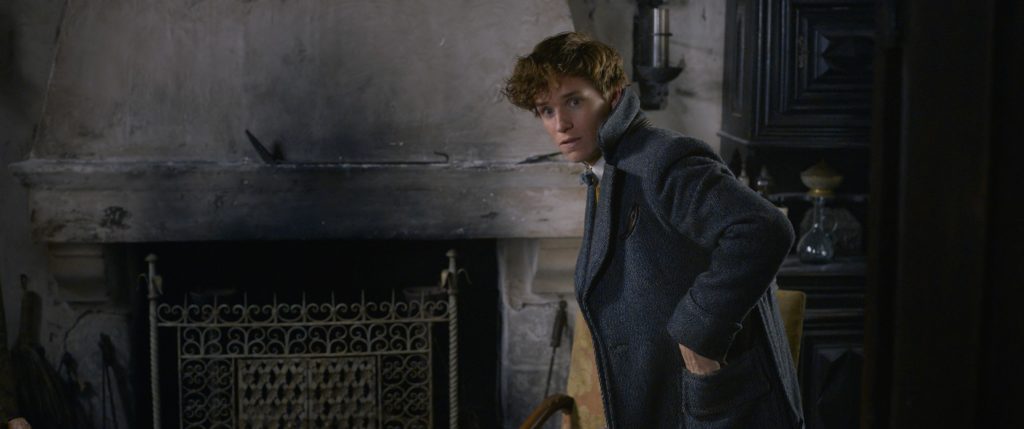
Press: Everybody knows the iconic uniform. What’s your take on it? How did you change it for this movie?
Colleen: Well, it’s a fairly classic look, but in this movie, I had Hogwarts in two different time periods. So for the earlier period, I did a nod to the earlier period: a longer skirt, ankle boots, the sweater/shirt setup’s the same… And then for the ’30s take on it, I just shifted it into that. I mean, the robe is based on a medieval robe, basically; those robes are a very old design. I sort of took them out of the choir robe thing and did a little bit more trim on them; I did some velvet trim on them. And then the hoods are the House colors inside, and so we did some fun things like that, but they’re pretty classical.
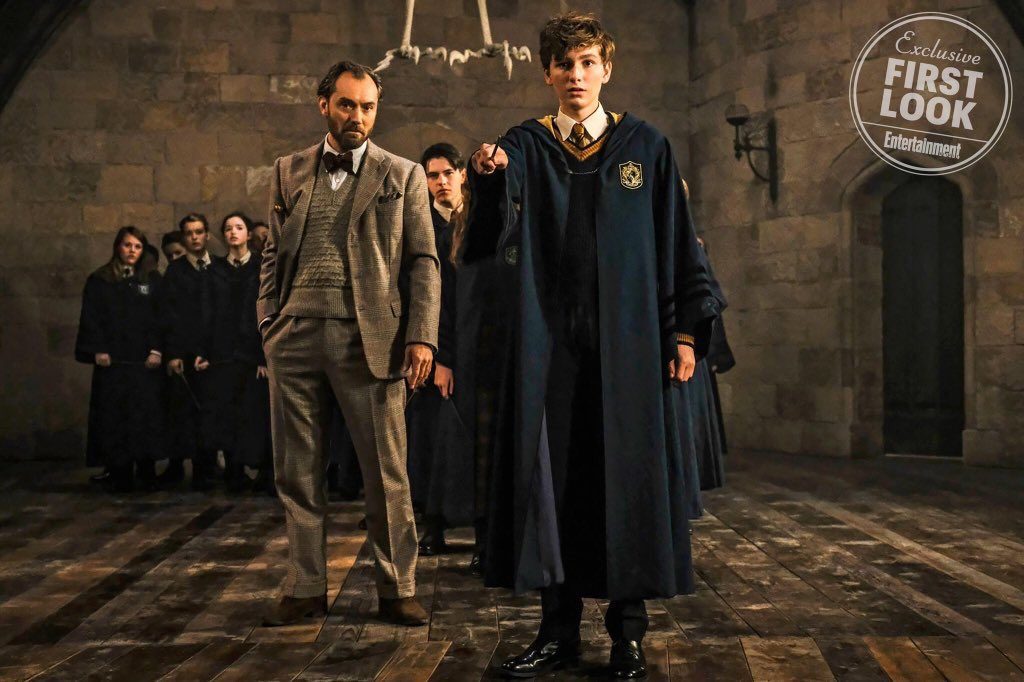
Press: Talk about the design for Leta Lestrange. Is she going to go in the super dark Helena Bonham Carter direction or a little bit lighter and less Goth?
Colleen: We’re looking at the ’30s here; we’re looking at a period where it’s modern, in a sense, compared to Victorian. Even though Helena was in modern times, her nod was definitely to the Victorian, but with Zoë Kravitz, who plays Leta, we did a much sleeker, more pared-down version. She’s [to] the manor born. She’s an aristocrat. And I played up sort of the glamor that an aristocrat of that period would have in the world of magic.
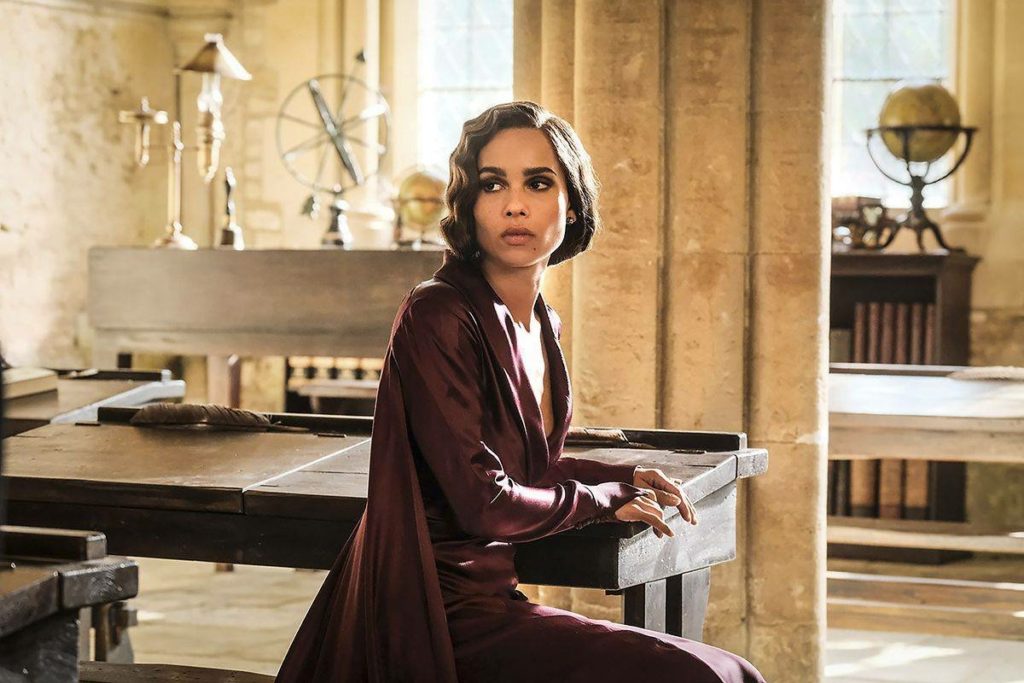
Press: Tina has a lot more confidence this time around after [the] success of what happened [in the last film]. She’s reinstated as an Auror. How are you translating that into her costumes?
Colleen: Well, we played around in the beginning, because we sort of went with a dress look at the beginning, like a cape and this great dress, and she’s become [at] the level of Carmen Ejogo in the last one – not quite, but sort of [a] more political look – and then we went back to her sort of detective look, so we went back to the trousers. And we did this coat that is this blue leather trench coat that’s really cinched around her that looks fantastic on her because she’s so tall and thin, but it also is empowering, and I based it [on] a real period sort of trench coat. So it’s this really beautiful dark navy-blue color, so it’s quite striking on her physique, but it feels powerful. When you see her, you feel like she’s got some chops. [laughs]

Press: Talk about the French influence this year and the French Ministry.
Colleen: Well, I sort of mixed it up. The period’s a lovely period, but I also found an eccentric sort of morning suit sort of look on some of the older gents, and it’s sort of a combination of that and just a spiffier look on the guys. You don’t see that many women in the [French] Ministry of Magic, but we will see them, and when we do see them, we’ve shot that, but those people will recur, and they’re quite striking, and we also have the French Aurors, which… They’re a good look. JSo we’re getting into [those] in a couple [of] weeks with the sheet [unintelligible].
Press: I covet Queenie’s dress from the first movie. What are we going to see her in in this one?
Colleen: Well, I had a great first fitting with Alison [Sudol]. We’ve sort of talked about, like, “Where do you think you’ve gone?” Because I always say that with these guys [who] come back. They’ve thought about who their characters have become. And she says, “I was thinking I might wear a tartan, a plaid,” and I was like, “Oh, I’d never thought of that.” [laughs] But I had this old piece of plaid fabric that I’d bought, strangely enough, in Germany that was a vintage piece of fabric, and I took it and I reworked it and I printed it for her dress, and it’s a plaid, but it’s not quite a tartan. It’s happy; it’s got a Queenie quality, like Queenie has moved on, but it has that sort of Queenie quality to it.

Press: Johnny Depp had quite a lot to say about his pirate’s costume. I wonder if he’s had any input into his look here.
Colleen: Well, I’ve dressed Johnny a lot in my life, in different things, and he always has a certain style and something he brings to the table as an actor. He has a physicality that works great in costume because he just owns it quite easily, but [with] this character, I sort of brought it to him and he was like, “Yes, let’s do this.” And then he has a look at the end that’s quite unique that we worked on together, and we’re camera testing him [at] the end of the week, so we’ll see how it all flies. Because I’ve done several looks on him, but it’s an overall look, and it’s a different take, and I think it’s fresh and it’s going to be great on him.
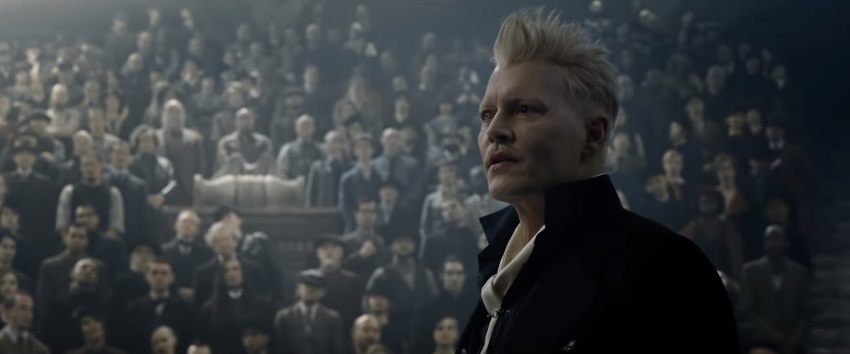
Press: His costume is unique.
Colleen: Really. It wouldn’t be there anymore, [laughs] but what I did is, I used hand-woven fabric that felt ancient, and I did a couple [of] different versions of him in the beginning for David because we weren’t quite sure where we were going to go with who he was. And when I read up on Flamel and looked at alchemy and people in that period, I did a more merchant look, which was a plausible solution for that character in time. And then we decided he was in a lab environment, so we sort of wanted to go with a more minimal, almost spiritual look for the character, which is based on an underrobe more than an overrobe because usually, they’d wear the big, heavy velvet robes over it, but we went much simpler with his character, and it worked better with the light hair and everything, and you could buy it as an ancient lab robe.

Press: How many of these costumes did you physically have to make yourself and how much were you able to pull from other sources?
Colleen: [laughs] The principal costumes and the featured characters like Aurors and all those characters we make. We have a lot of people [who] come in for a day, and it looks simple, but then all of a sudden, they have a stunt double, a photo double. There’s a lot of action with these kinds of movies, so it’s better to make the costumes. I don’t know if you’ve been to set today, but the people you see walking around on the streets [who] are vendors (coats and hats and those things), and the crowd, as we call them, or the extras, their clothes are rented. So those are rented from England, from Italy, from Spain, from America… Different countries and different costume houses have strengths, so I just sort of pull from everywhere because at this point in the history on the movie, I think we’ve done 2,500 fittings and we probably have about 400 or 500 to go. So all those clothes get worked more than once because we finish with the crowd [and] we clean them and we recycle them again in a different configuration, but just for the scope, with the number of fittings that you have to do with [the] crowd, a lot of that stuff’s rental.
Press: Do you approach costumes differently? Are there things that you can and can’t do in the costume? It almost has to have a period look to it, and those costumes, you’d assume, don’t allow for that much physicality.
Colleen: Well, they also don’t come in the sizes that you need, but I have stretch panels and things like that you don’t see but that make it so the actors, especially someone like Eddie, who does a lot of physical movement, can actually move in their costume in a way that works for [their] character[s], where, like you said, a real period costume would be quite restrictive.
Press: In the first movie, Credence is in all black. But he’s free now; he’s in the circus. What was that like to take him to that next place?
Colleen: Well, I mean, I love Credence. I love his character. I love who he’s becoming, and I also think Ezra Miller is a spectacular young actor, a really great actor. And so it’s fun to work with him on where we’re going with it, and he loves a costume, so he’s a costumer’s friend. And so Ezra at the beginning of this is sort of a bit more of himself, but he’s owning it more, so he doesn’t have his very eccentric haircut. He’s not hiding who he is so much, so he’s opening up to the world. So instead of black, I used warmer colors; I used some black. I used some things that are reminiscent of who he was before because I think, even in your life as you change, you don’t like, “Well, this year, I’m going to wear all red and next year I’m going to wear all…” We take the things that are us and move them on in our lifetimes, and that’s what I’m trying to do with these people and the same with Credence, even though before, he was such an extreme character.
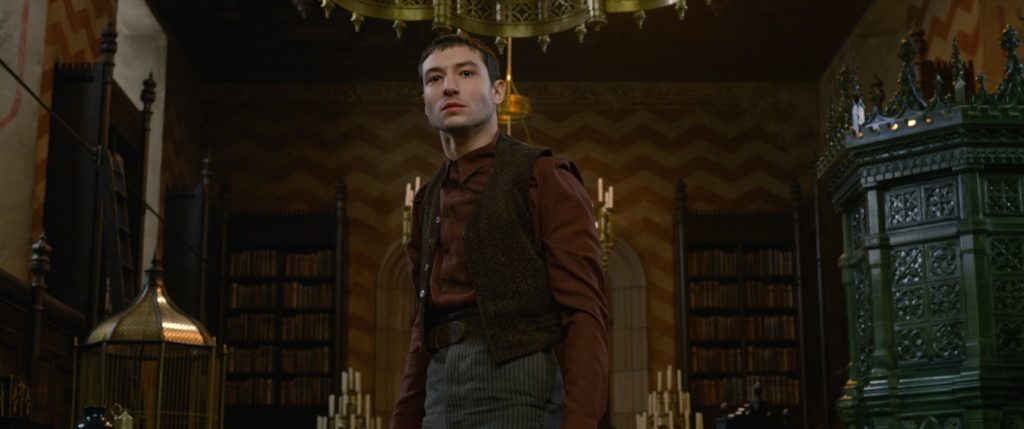
Press: How different are they as people and is he going to have more of a sleek look?
Colleen: Yes, he has a more official feeling to him. I would say he’s like the middle child; he’s trying to do everything the right way, so even though in his heart he may be different [from] that, he’s trying to, to all appearances, be like a young, ambitious wizard [who]’s coming up in the world of wizardry and in the world of government.
Press: What is it about that character that moves you so much?
Colleen: Well, when you read into the character, he’s quite a tortured soul. He’s a victim of happenstance, and he has a different journey than other people, and maybe as an artistic person, I connect with that kind of character in a way. In a similar way, I connect with Newt’s character, who is somebody [who]’s a little bit of an outsider too.
Press: How large is the costume department?
Colleen: When I don’t have massive crowds, the running costume department is probably around between 70 and 100 people – that’s aging, dying, textiles, fitting – because the whole time we’re shooting, we’re fitting costumes for the next scene, so I have a team of six people doing that, six people altering that, six people aging that, so it’s on and on. And then, for instance, the opening scene of the movie, it’s maybe 12 people in the scene, but because of the number of multiples I need for the scene, it’s over 100 costumes because I need so many different stunt versions and different versions and variations of the costume. So it does fluctuate, but basically, that’s the heavy load. And then it goes up when you have a big crowd day, a day that people come in for the day and help.
Press: How does the Harry Potter circus differ from the Tim Burton circus?
Colleen: It’s a really different circus. I mean, the Tim Burton circus, the circus of Dumbo, is an American circus. It’s a very “Let’s embrace Americana” in the way that a circus goes from very poor to huge to sort of controllable again. In this story, the circus is much grittier; it’s a night circus, so it’s much closer, in a sense, to a carnival or sideshow or freak show than a real circus in the American sense of the circus. There’s a history of [the] circus in France, or littler circuses, and they sort of had that vibe, so it’s much darker and couldn’t be less American in its style.
Press: What did you look at for inspiration?
Colleen: For this film, for the circus characters, I did some French circus research and sort of more sideshow/freak show research, and then I took it to a place I wanted to take it that was a little bit different [from] that that I thought could work. I can’t spill the beans about what this all is, but it all ties in with who they are in the circus.
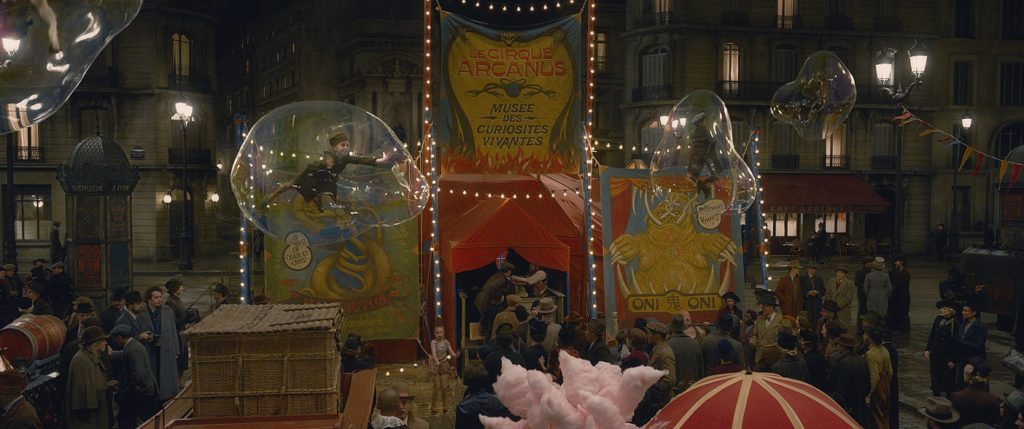
Press: Some of the props weren’t available because they were either on tour or in an exhibition somewhere. Was that the case with some items of clothing?
Colleen: Well, I mean, I wasn’t really reusing clothing in the sense that a wand or something like that might be reused. The only thing that was on the road and [that] we had very scarce of [is,] in the first film, Tina has a necklace that you don’t really see in this one, but she wanted to wear it because she’d worn it in the first one, and I had to go get it off [laughs] the display to make some more duplicates of it, so it got borrowed for a few weeks.
Press: Have there been any costume mishaps so far on set?
Colleen: Not that anyone’s told me, but I’m sure there have been; there always are. [laughs] Somebody steps on somebody’s tail or something happens, but luckily, for all these costumes that are working on the big players, there’s definitely a backup costume.
Press: Which character’s costume has been the most challenging to bring to life?
Colleen: Well, I’m not done yet. [laughs] I suppose it’s more not an individual costume; it’s more like how to get the Grindelwald world its own world that’s coming into its own and how to sort of get the different individual worlds of the Aurors and the different national groups and all those kind of characters together and evolve the main cast at the same time into a world. So the big challenge to me isn’t one costume, per se. I mean, there’s always one that’s a headache and you’re just like, “Oh, why isn’t this working?” But it’s more like trying to get the whole world into something that feels fresh and alive and that can have a journey forward in time.
Press: When [they’re] working with some of the magical creatures, do you have input into what colors [they’re] wearing versus what the colors are that those creatures are?
Colleen: I look at what colors are around them as far as the creatures go, but I really focus on their costumes more with their character than related to the creatures because they’re in the movie a lot more than the creatures are.
Press: Was there a piece or a look in this upcoming film that you would say had the most story behind it?
Colleen: I don’t know yet. I mean, the story hasn’t really been told, so until you actually visually see it, the journey isn’t made, so sometimes you do something that you don’t realize is going to play a lot more and sometimes you do things that you think [laughs] are going to play and they don’t at all. When I look at the movie, it’s quite surprising. In the last movie, we made all these pockets for Eddie [Redmayne] in his coat for creatures and thinking they’d be crawling out and stuff all the time, and it didn’t play at all. So you never know where it’s going to land, but I suppose that for me, the sort of evolution of – I call them the Big Four – where they’ve become is the biggest connective tissue to the past and potentially the future.
Press: Has Joanne seen something that you’ve done and said not to do it that way?
Colleen: Not yet, but we’re not done. [laughs] It could happen. She gives notes on how she sees a scene or something like that, so she’s helpful in that way, but she does it before as opposed to after, which is always a plus.
Press: You have the book to reference.
Colleen: Yeah, it’s different. But you have the pages in the script, so you get an impression of it, and then sometimes she gives additional notes on how she thinks the people in the room should be like, if she thinks they should be a little more threatening or not, but I mean, she’s so on it. I mean, she’s way ahead of me, where she’s going with it, so I feel like her notes are already there. But I mean, she approves everything.
Press: Have you taken inspiration from classic film noir at all or have you drawn inspiration from elsewhere?
Colleen: My inspiration definitely reflects film noir, and I love the way The Third Man looks; I mean, it’s a great-looking film. The use of light and shadow is beautiful. It’s not set in Paris, I don’t believe, but with Paris as a backdrop, it’s helpful, too, for design because you get a French take on it but with the lighting of the noir films. [Editor’s Note: The Third Man is set in Vienna, Austria.] So it’s definitely a player in my inspiration too. That was David Yates’s big note; he really liked the noir feeling for this one.
Read the rest of our set visit coverage here.
This interview has been edited for clarity. Additional formatting provided by Felicia Grady.

